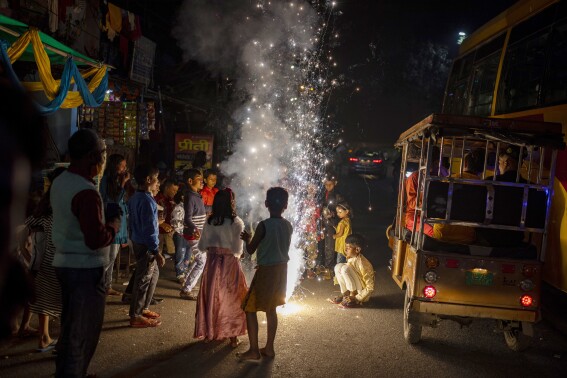Your support helps us to tell the story
Support NowThis election is still a dead heat, according to most polls. In a fight with such wafer-thin margins, we need reporters on the ground talking to the people Trump and Harris are courting. Your support allows us to keep sending journalists to the story.
The Independent is trusted by 27 million Americans from across the entire political spectrum every month. Unlike many other quality news outlets, we choose not to lock you out of our reporting and analysis with paywalls. But quality journalism must still be paid for.
Help us keep bring these critical stories to light. Your support makes all the difference.
As the weather turns cooler, a familiar warmth spreads through many communities around the world. It’s the season for Diwali and the bustle as the planning for the festivities gets under way is palpable. There will be light in the dark autumnal nights, sparkles, fireworks, glitter and much feasting – the perfect recipe for bringing friends and family together.
With these key ingredients, it’s no wonder then that this celebration and its symbolism has far greater meaning and resonance than religion alone.
Diwali is the Indian festival of lights. While it is often described as a Hindu festival, it is also commemorated by Jains and Sikhs. It is celebrated across India, particularly in the north and parts of south India, and is known as Tihar in Nepal. The term Diwali is derived from the Sanskrit word Deepavali (or dipavali) meaning a row of lights represented by the twinkling clay diyas that are lit for the festival.
The date of this auspicious occasion is an eagerly awaited annual event, much like Christmas. Diwali is celebrated on Amavasya, the darkest, moonless night in the month of Kartik, which falls during mid-October, mid-November. It lasts five days and marks the start of Hindu New Year.
In north India, it concludes the harvest season for farmers. Hindus there celebrate the story of Ramayana, the return of the jubilant Lord Ram to his Kingdom of Ayodhya after 14 years in exile, following his fierce battle with the evil king Ravana.
In Bengal to the East, people worship Durga and Kali, the female demon slaying warrior powerhouse goddesses and symbols of strength. South Indians celebrate Lord Krishna’s victory over the wicked king Narakaasura.
Lakshmi, the goddess of wealth, also makes an appearance around this time. Legend has it that she was created at the start of Diwali. She makes an annual visit to bless homes that uphold Rama’s values of hard work, dedication, perseverance and integrity with wealth and abundance. Her son Lord Ganesha is a symbol of prosperity that sits alongside her. A rotund boy with an elephant’s head, he has a weakness for sweet laddoos. Unsurprisingly, merchants and traders start new accounting books around this time with great hope for business success and profitability.
The themes of Diwali celebrate the triumph of good against evil, the victory of light over darkness and the importance of hope and hard work. These are universal and transcend religious and geographic borders in the diaspora. Over time, Diwali has become a major cultural event globally that fosters community spirit, eating together, dressing up and festivities. It is a public holiday in many countries including Fiji, Guyana, Trinidad, Pakistan, Malaysia, Mauritius and Singapore. Pennsylvania and New York have declared Diwali a public holiday too.
Planning for the holiday commences early and food is at the heart of it. There is a big tradition of snacks, food gifting and sharing at this time of the year. Markets are flashpoints for community camaraderie, hustle and bustle and the iconic Borough Market is my go-to destination to source the highest quality produce with strong ethical and sustainable credentials too. The various nut brittles of Food & Forest, chocolate pouches of Chocolicious, premium dates from Date Sultan and the chutneys from Temptings are all always on my gifting shopping list.
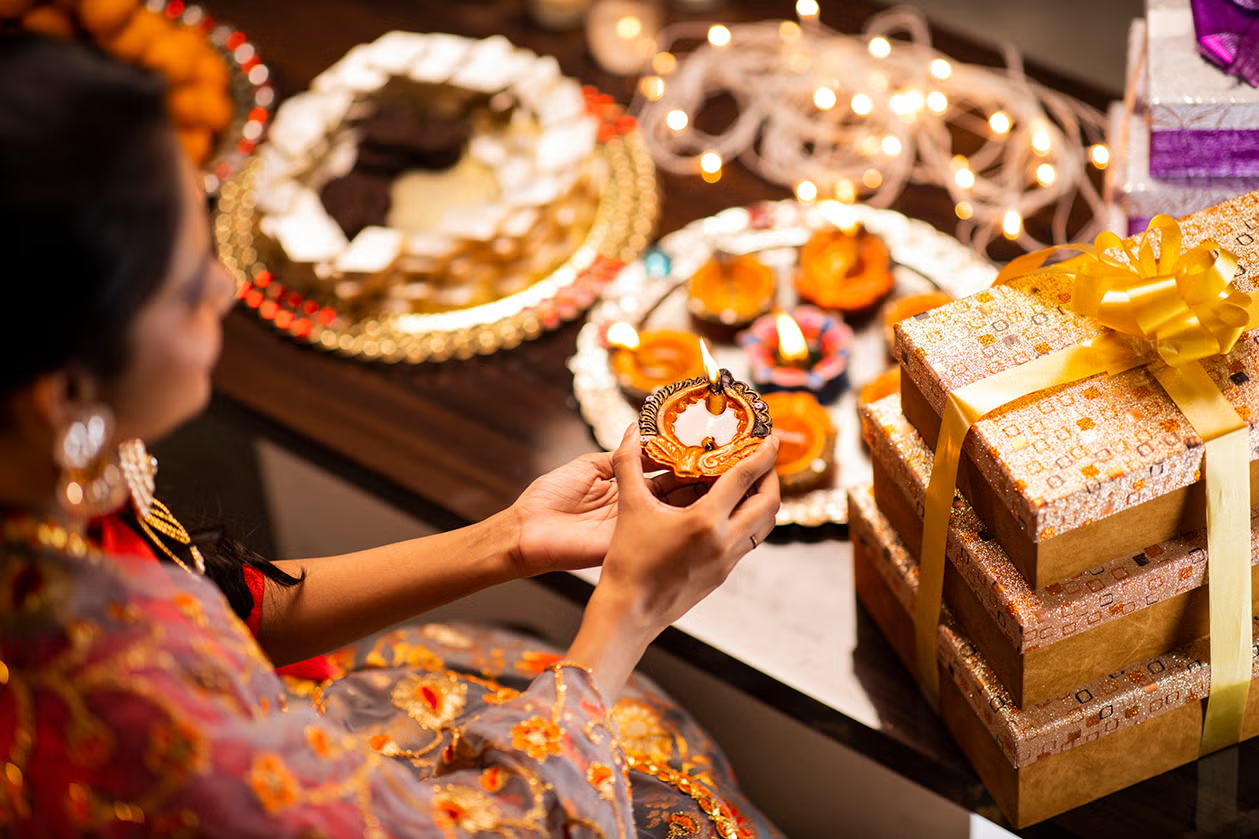
Gifting aside, daily meals are Sattvic, pure and fresh, simple and delectable at this time and many choose to be vegetarian. Onions and garlic are also not allowed, and home cooking is promoted over convenience food. The auspicious period starts with Navratri, or nine days, which lead to Durga Puja and Diwali. Meals centre around seasonal vegetables like sweet potatoes, pumpkins, taro and yam and there are plenty of options befitting a delicious feast at the Market.
For me, embracing the joy of shopping for fresh produce, piled high in beautifully co-ordinated, tumbling mountains is a huge part of the celebratory feel at this time of year. As for what goes with them, rice and wheat are prohibited for the most devout of fasters, with heritage grains like amaranth, buckwheat and millet featuring more prominently.
Perhaps the most decadent feasting comes in the form of savoury and sweet snacks. These involve lashings of sugar and ghee, deep frying, and heady aromatics like saffron and cardamom that fill the air with the sweet promise of joy and togetherness. Sugar and ghee are both auspicious ingredients, so consider these treats divinely ordained. You might want to grab a jar of the rich and decadent ghee from Hook & Son, organic and from grass fed cows in Sussex. Dressed to our nines in new traditional clothes and all the jewellery, it is customary to indulge with the people we love.
The celebrations differ from family to family, and there is a difference between what happens in the motherland versus the diaspora. In India, for instance, it would be more usual for families to get their sweet and savoury treats from professional sweet makers. In the diaspora, many choose to recreate these at home to create that special bond with festive eating in addition to home deliveries. It’s not uncommon to purchase sacks of spices, milk powder, gram flour, almond flour and more in the run up to Diwali. For those unable to make or source more traditional mithai (sweets), brownies from Cinnamon Tree Bakery, fudge from Whirld, candied treats from Maggio’s Confectionery and 18 varieties of Turkish Delight at Turkish Deli at the Market should do the trick.
The treats are then laid out for sharing with family and friends in gatherings that include Puja (prayers), lights and fireworks, Rangoli, elaborate patterns made with coloured powders and card playing. It’s a family friendly affair, with children running around fuelled by sweets, excitement and gifts of cash a time-honoured tradition.
If it sounds like a celebration of epic proportions, it is. And everyone is welcome to join the fun. If you’re invited to a Diwali party in someone’s home, you might want to check the dress code and go in your finest and brightest. Alcohol is drunk in homes around this time, but it’s worth checking. Finally, please do ask what you can bring along. Food gifts around this time, as with most times in the year, make the best gifts.
If you’re not lucky enough to be attending a Diwali party, this is the perfect time of the year to gather friends around for a celebratory Indian feast. Think creamy vegetable curries, steaming hot dal and spiced autumnal drinks, with a sweet or two to complete the meal. With seasonal ingredients sourced from your favourite market traders, it may be the most wonderful way to bask in the spirit and true meaning of Diwali.
Broccoli, smoked garlic and lime dal

Recipe by: Mallika Basu
Lentils get a smoky treatment in this buttery dal. A whole broccoli melts into the dal as it cooks, with not a single bit wasted, and the lime lifts the lot with its fresh tang. This would make a great centrepiece and talking point for a Diwali celebration. Can anyone tell what vegetable went in it?
Serves: 4 as a main, 6 as a side
Prep time: 5 minutes | Cook time: 30 minutes
Difficulty: easy
Ingredients:
For the dal:
200g red lentils
450g broccoli
1 tsp turmeric
Smoked salt, to taste
For the tempering:
4 tbsp ghee
6 cloves of smoked garlic, peeled and sliced
1 tsp cumin seeds
A pinch of chilli flakes
Juice of 1 small lime
Method:
1. In a saucepan, wash the lentils with cold water, draining and refreshing until the water runs clear. Cover with cold water to about 3cm above the lentils, then slowly bring to the boil. Keep a kettle with freshly boiled water handy.
2. Chop the broccoli roughly into small florets and pieces, using the stalk, leaves and all.
3. Skim and remove any foam that rises to the surface when the dal is bubbling, then mix in the turmeric and the broccoli. Add enough hot water to submerge the broccoli completely.
4. Cook the lentils for 20 mins until the broccoli is soft, then smoosh it into the lentils with a potato masher. It should thick but still liquid. Take it off the hob and mix in smoked salt to your taste.
5. To make the tempering, bring the ghee to a medium-high heat in a small pan. Fry the garlic cloves until they start turning golden, then sizzle the cumin seeds and mix in the chilli flakes. Turn the heat off and squeeze in the lime. Pour this over the dal then serve with lots of warm flatbreads of your choice.
Cumin gouda and cheddar tikki chaat with tropical kachumber
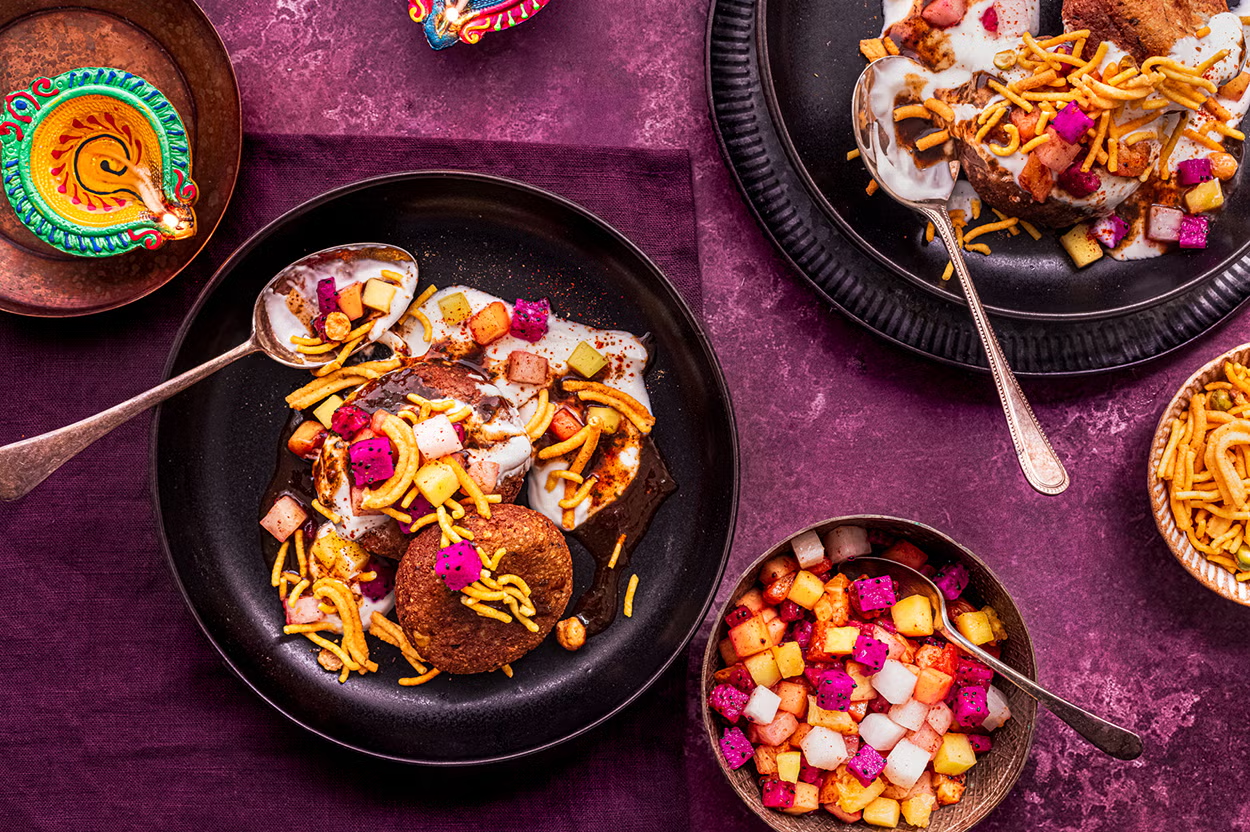
Recipe by: Gurdeep Loyal
The word “chaat” – the collective term for Indian street-food snacks – broadly translates as “to lick”, and this cheesy, tangy, crunchy Diwali chaat recipe is sure to get your guests licking their lips immediately.
Sizzling “tikki” hot cakes are found in carts all over the streets of India, laden with toasted spices and herbs, then always smothered in chutneys. The tikkis in this recipe have chickpeas as their base, amplified by the addition of cumin gouda and the sharp bite of vintage cheddar – although you could use any strong hard cheese you like. The kachumber adds tropical freshness, the yoghurt a cooling creaminess and the duo of tamarind and mint chutneys a zingy sourness.
As with all Indian celebration foods, garnishing with crunchy bits is essential: the mingling of loud flavours and textures, all eaten together at once, bring the very essence Diwali partying!
Serves: 6-8
Prep time: 30 minutes plus 10 minutes resting | Cooking time: 15 minutes
Difficulty: medium
Ingredients:
For the tikki chaat:
1 large jar of cooked chickpeas, drained
85g extra mature cheddar, grated
85g cumin gouda, grated
2 tbsp chaat masala
20g fresh coriander, very finely chopped
2 spring onions, very finely chopped
1 tbsp finely grated ginger
100g self-raising flour
For the tropical kachumber:
200g mango, diced small
200g pineapple, diced small
200g dragon fruit, diced small
100g daikon mooli radish, diced small
1 tsp cumin powder
1 tsp Kashmiri chilli powder
2 tbsp lime juice
½ tsp lime zest
A pinch of caster sugar
For the tamarind sauce:
3 tbsp tamarind paste
3 tbsp jarred mint sauce
2 tbsp runny honey
Plain yoghurt, to drizzle
Sev or bombay mix, to sprinkle
Method:
1. Start by making the kachumber. Dice the mango, pineapple, dragon fruit and daikon radish into small cubes. Mix them in a large bowl then add the cumin powder, Kashmiri chilli powder, lime juice, zest and caster sugar, along with a good pinch of fine sea salt. Mix well, cover and leave to one side.
2. Make the tamarind drizzle by whisking the tamarind paste, runny honey and mint sauce together in a bowl, with a splash of water if it’s very thick. (Make sure you’re using a tamarind paste, not a concentrate.)
3. Tumble the drained chickpeas into a food processor, then pulse to a thick coarse mash with a few chunks left in for texture (you don’t want a completely smooth puree). Alternatively, you can do this manually with a potato masher.
4. Scrape the chickpea mash into a large mixing bowl, then add the cheddar, cumin gouda, chaat masala, fresh coriander, spring onions, ginger, flour and a good pinch of fine sea salt. Use your hands bring the mixture together, ensuring the ingredients are well combined into a thick mix, adding an extra tablespoon of flour if it’s very wet. Cover the bowl and leave aside for 10 minutes.
5. Give the mixture another quick mix, then shape into 8cm x 6cm diameter round cakes. An easy way to do this is to use a 6cm ring mould, tightly packing the tikki mix in, then sliding out into perfect circles.
6. Heat 2cm of vegetable oil in a large frying pan to 160C. Shallow fry the tikkis – no more than two or three at a time – for 4 mins in total, turning every minute until golden brown on both sides and cooked through. Be very careful as you turn them as the oil can spit! Drain on kitchen paper.
7. To assemble, plate up the warm cheesy tikkis with a dollop of yoghurt and a good drizzle of the tamarind sauce. Spoon over some of the tropical kachumber, sprinkle with sev or bombay mix for crunch, and enjoy!
Spiced hot chocolate with cinnamon, peppercorns and cardamom
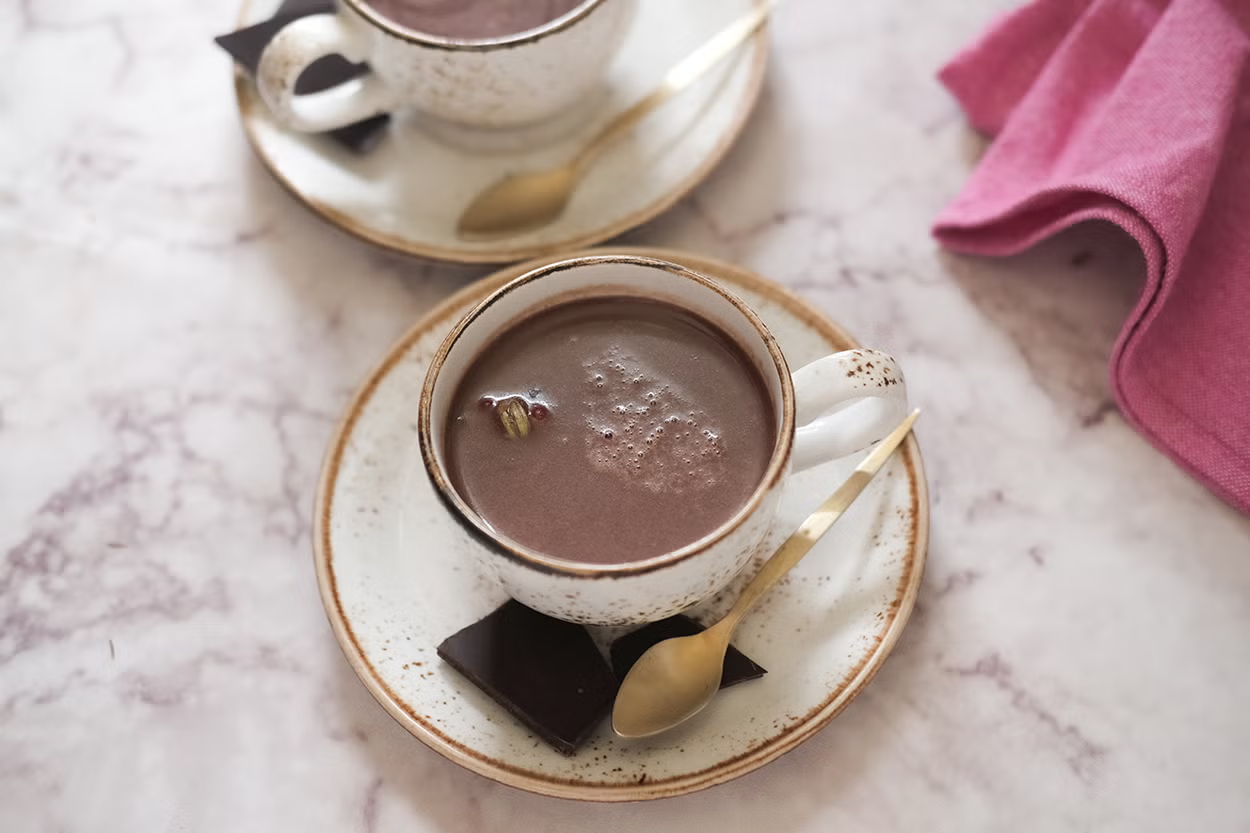
Recipe by: Mallika Basu
This rich, molten chocolate has all the promise of a warm hug. Steeped in fragrant spices it takes its inspiration from masala chai to provide a heady version of hot chocolate. Add a dash of rum for a boozy, grown-up version.
Serves: 4
Prep time: 2 minutes | Cooking time: 10 minutes
Difficulty: easy
Ingredients:
6 green cardamom pods
1 tsp mixed peppercorns
6cm cinnamon stick
600ml whole milk
70g dark chocolate chunks, chopped into small pieces
Agave nectar or honey, to taste
Dark rum (optional)
Method:
1. Lightly bash the mixed peppercorns and green cardamoms in a pestle and mortar until they split. Add to a heavy bottomed saucepan along with the milk and cinnamon. Bring to a gentle boil, stirring regularly.
2. Lower the heat to a simmer and steep the spices for five minutes. Now mix in the chocolate, stirring well until it melts, then turn the heat off. If you keep cooking it, the chocolate will turn grainy.
3. Strain into two cups, adding agave nectar or honey to taste. For a grown-up vibe, add a little dark rum. If reheating to enjoy, add a splash of milk to loosen the drink while warming it.
Strawberry, tonka beans and pistachio butter kaju burfi
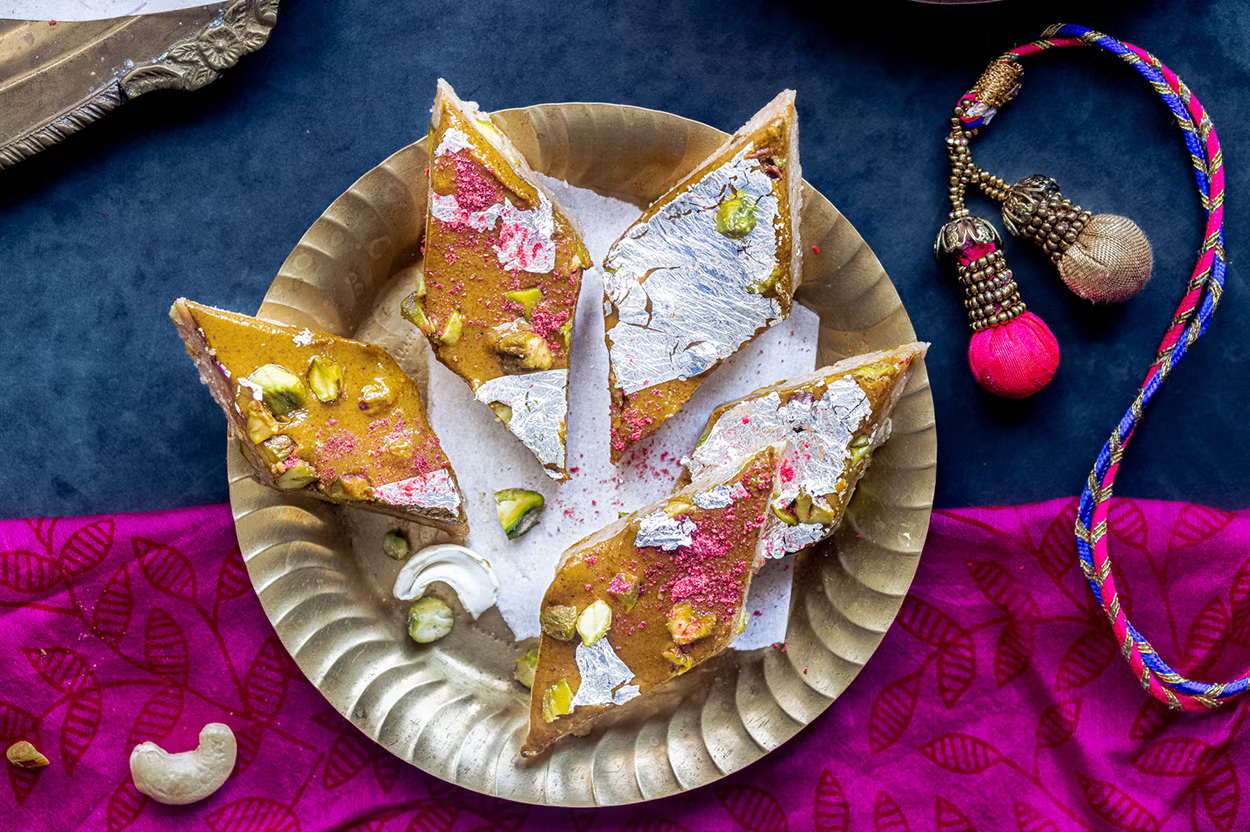
Recipe by: Gurdeep Loyal
Cashew burfi or “kaju katli” is among the best-loved Indian sweets around the world, and its signature “shining diamond” shape makes it especially popular for Diwali, the festival of light.
My Borough Market twist on the classic adds the fruity sweet-sourness of Spice Mountain’s strawberry powder, combined with the floral-vanilla hit of grated tonka bean – a combination of flavours that is wonderfully familiar but also surprising at the same time.
To make this recipe extra special, there’s a decadent pistachio butter topping, made using the 100 per cent pistachio butter from Oliveology, which has a rich roasted toastiness. What’s more, this recipe is vegan so can be enjoyed by all. Silver leaf optional, but great for dazzling the eyes as well as the taste buds!
Serves: 18-20 pieces
Prep time: 45 minutes plus 30 minutes freezing | Cooking time: 10 minutes
Difficulty: medium
Ingredients:
350g raw cashew nuts
225g caster sugar
2 whole tonka beans, very finely grated
3 tbsp coconut oil
1 tsp vanilla bean paste
2 tbsp strawberry or raspberry powder (I used a mix)
215ml jar of 100% pistachio butter
65g roasted pistachios, finely chopped
¾ tsp fine sea salt
Edible silver leaf, to garnish (optional)
Method:
1. Place the raw cashews in a freezer bag and put into the freezer for 30 mins so their oils firm up. Put the cold cashews into a food processor, and pulse to a very fine powder – do this in batches so you don’t overcrowd it. Sift into a bowl, blitzing any larger chunks again until it’s all very fine and powdery.
2. In a large non-stick frying pan, add the sugar along with 125ml water. Gently heat for 3-4 mins until the sugar has fully dissolved and the liquid is only just starting to boil. Remove from the heat, then tip in the fine cashew powder, 1 tbsp coconut oil and the fine sea salt. Use a rubber spatula to mix well.
3. Return the pan to a low-medium heat and continuously stir for another 4 mins, scraping the mix from the bottom of the pan continuously with the spatula to stop it catching (this will take a little elbow grease).
4. When it’s starting to thicken, stir in the fruit powder, grated tonka beans and chopped roasted pistachio nuts. Continue to cook on a low-medium heat – scraping, folding and turning the fudgy mixture continuously – for another 6-7 mins until it’s starting to come together as one from the sides of the pan. Be patient, and don’t be tempted to turn up the heat – it will eventually start to come together.
5. Remove from the heat and cool for 25-30 mins, using your spatula to turn and fold it every 5 mins, resulting in one large ball of cashew fudge. Line a 23cm x 23cm square cake tin with cling film while you wait.
6. When cool enough to touch, empty the ball of cashew fudge onto a silicon matt or piece of baking parchment and knead for 1 min. Then either roll out or press the strawberry fudge into the lined cake tin in an even layer approximately 1cm thick. Leave to one side.
7. If the pistachio butter in the jar has separated, mix together so it’s a homogenous consistency. Add 2 tbsp coconut oil to a small saucepan and heat gently, just to the point where the coconut oil has fully melted. Remove from the heat, then add all 215ml pistachio butter, using a rubber spatula to mix the oil and pistachio butter together into a silky pourable topping.
8. Pour the pistachio topping over the layer of fudge, sprinkle over more chopped roasted pistachios, then leave to set in the fridge for at least 5 hours, ideally overnight.
9. When it’s set, the bottom strawberry layer will be a dense burfi fudge, while the pistachio topping will be just softly set. Cut into 18-20 Diwali diamond shapes, garnishing with extra strawberry powder and festive silver leaf if you like.
For more tips, recipes and information on what you can find at Borough Market, visit: boroughmarket.org.uk
Disclaimer: The copyright of this article belongs to the original author. Reposting this article is solely for the purpose of information dissemination and does not constitute any investment advice. If there is any infringement, please contact us immediately. We will make corrections or deletions as necessary. Thank you.


